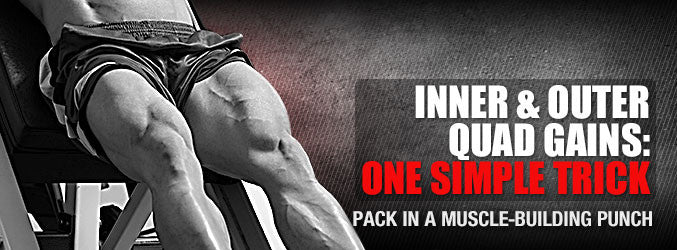
When it comes to building muscle in the iron game, there is no universal starting line. There are athletes who have never touched a weight in their lives, whose physiques already surpass anything you’ll ever be able to achieve with a lifetime of dedicated training and nutrition. On the other hand, there are lifetime training, world-class bodybuilders with smaller calves than those seen on some kids playing high school soccer. Genetics can be your best friend, or worst enemy. Even the most gifted athlete in the muscle game, Phil Heath, still has to face narrow clavicles in the mirror each morning, despite his arms being the best the world has seen since Ronnie Coleman.
Once we accept the fact that we all start with different muscle potential, it becomes easier to address those flaws we identify with our own physiques. Only then can we begin addressing them, targeting our weak areas and turning them into strong areas, using time, training, and plenty of patience. The inner and outer quadriceps are one such muscle group.
The leg extension is one of the most commonly used exercises in every gym in the country. It can be used by trainers of any age without much supervision or instruction. The mechanics are simple, and you can go from very light, to very heavy, with just the move of a pin. It’s not a huge mass building exercise, and is commonly used more as a finishing movement following training, but it can pack a muscle-building punch in a targeted manner when used correctly.
Are you ready to use leg extensions to better isolate and target the muscles of your quads? Let’s break it down!

There are two main areas of the quads that athletes are looking to target in order to find complete leg development. The inner quadriceps is known as the teardrop, because it looks like a falling tear when fully developed. The outer quad, known as the sweep, is named so because it creates a rounded sweeping effect when fully developed.
Now, what we’re dealing with today isn’t just bro science, concocted by gymrat personal trainers who just kinda “supposed” how changing things up may actually target the parts of the leg better. Rather, actual researchers used an MRI machine to measure just how much the muscle fibers of the legs were activated during standard training. They used the leg extension, a highly popular machine available in nearly every gym in the country, to examine how changing toe position could have effects upon muscle fiber stimulation in various groups of leg muscles.
The science doesn’t lie. What they found was an inverse relationship When the lifter points the toes INWARD, keeping the legs straight, the OUTER quads were targeted, forcing the outer vastus lateralls and vastus intermedius to carry the brunt of the workload. On the other hand, pointing the toes OUTWARD had the opposite effect, with the inner quad muscle groups of the fastus medialls taking on the brunt of the workload.
The muscle groups which conduct the most work will grow at a faster rate. Their fibers are stimulated, and torn, and beaten to a pulp with a high repetition leg extension workout. Since you likely have never pointed toes before, you are achieving muscle fiber stimulation in fibers which have never been stimulated before. This means you’ll actually see “beginner’s gains” in a muscle group you have been targeting for years, or even decades.
How does this affect you, the clever lifter seeking tips & tricks for finding better leg results? Now you know how to specifically target development in different parts of your quads, using the SAME exercise. A slight change in toe position allows you to train certain parts of the upper leg with greater intensity, and thus make greater gains.

Look at pictures of fully developed quad muscles on professional bodybuilders. Compare them to pictures of your own. Granted, you aren’t going to possess about 100 pound of muscle that they do, thanks to their super-supplement regimens. However, you can very quickly learn from studying their pictures exactly what balance & symmetry between the muscle groups of the quads should look like. If you are lacking development in one of these areas, you don’t have to just “wait it out”. You can now vary.

Keep in mind that you are altering a standard training exercise, which can have negative effects upon the body if done incorrectly. If you have any known knee injury issues, you will want to pay special attention to how your knee reacts to the change in toe position. Research shows that the greatest control over isolating the parts of the quad was achieved when the toes were point inward or outward at the greatest possible angle. In other words, just slightly modifying your toe angle might feel good, but you’re likely not altering your quadriceps muscles.
Extend this creativity to other muscle groups of your body. Maybe a small
Pay attention to make sure that as you deviate from standard and proven proper form on the movement in the name of new muscle fiber isolation, you’re not placing your joints and tendons into precarious positions. Record your results and decide which exercises for which muscle groups provide you with the most unique punch in terms of spurning new muscle growth by simply mixing things up!


